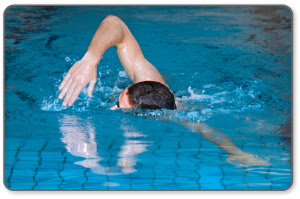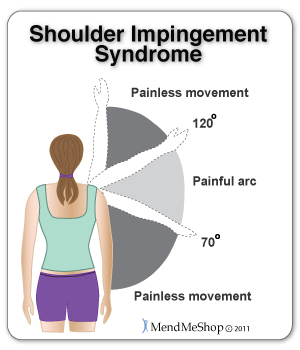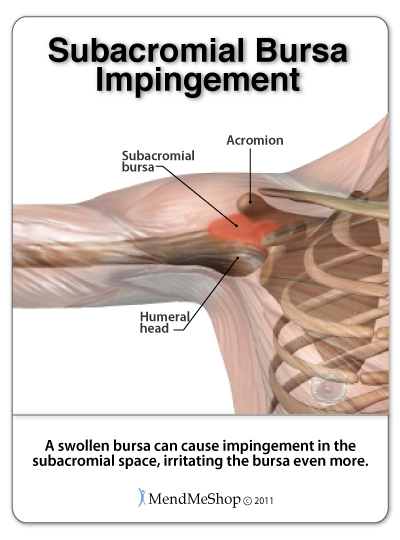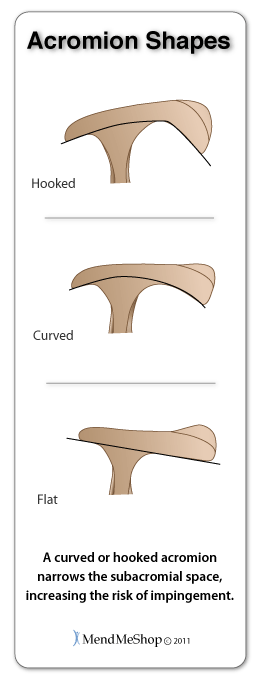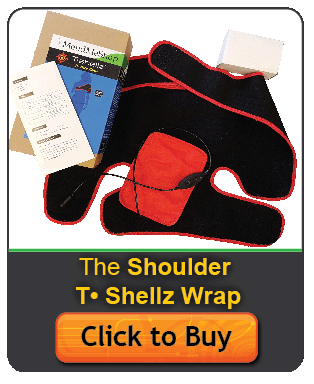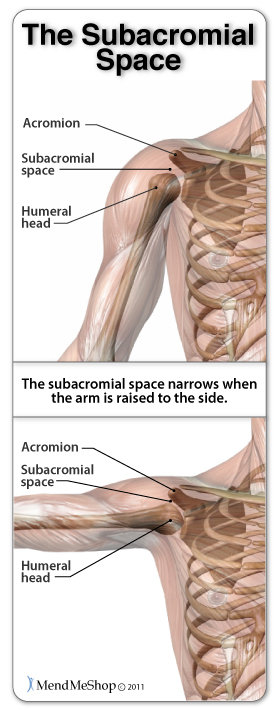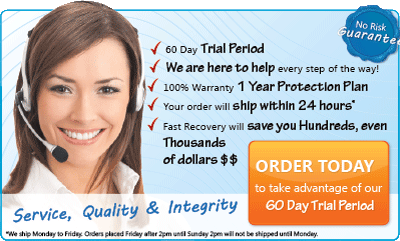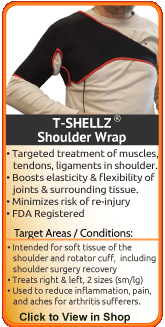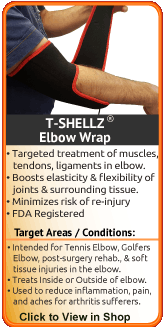Rotator Cuff Impingement Syndrome
Shoulder impingement syndrome occurs when soft tissue in the subacromial space (considered the 'roof' of the shoulder blade) is pinched.
The subacromial space is an area in the shoulder that's approximately 1/2 an inch wide between the humerus (upper arm bone) and the acromion (a bony projection of the scapula). As you raise your arm, the greater tubercle (head of the humerus) moves up towards the acromion process and the amount of space in the subacromial space is naturally reduced. When the shoulder is healthy and everything is functioning properly this narrowed space is not a problem.
The supraspinatus tendon and the subacromial bursa lie within the subacromial space. Therefore, these tissues are at the greatest risk of being pinched between the humerus and acromion process when you lift your arm. If the soft tissue in the subacromial space is swollen or the acromion is abnormally shaped, pinching or rubbing of the supraspinatus tendon may occur and/or it can cause a lot of irritation in the subacromial bursa. This pinching of the supraspinatus tendon or subacromial bursa causes the pain of shoulder impingement syndrome, which becomes worse as inflammation increases.
Abnormal narrowing of the subacromial space can happen as a result of bone spurs, thickening or calcification of the coracoacromial ligament, a curved or hooked acromion, a misaligned glenohumeral joint, or osteoarthritis spurs on the acromioclavicular joint. Alternatively, if the soft tissue within the space is larger than normal the space becomes even more narrow. This can occur with subacromial bursitis, or swelling or thickening of the supraspinatus tendon.
This condition is also referred to as swimmer's shoulder, pitcher's shoulder, painful arc syndrome, supraspinatus syndrome, and thrower's shoulder. Because it can mimic the symptoms of a rotator cuff tear, tendonitis, tenosynovitis, bursitis or other shoulder problems, it is wise to see a doctor to determine the cause of your shoulder pain.
Causes of Impingement
This type of injury can be caused by activities where you need to raise your arms above your shoulder (or head) such as; tennis, swimming, carpentry work, painting. lifting and football or other overhead sports. You may not be able to recall any specific event, injury or activity that would cause such an impingement.
Due to the narrow spaces within which your tendons and muscles operate (constrained by the acromion and humerus) an impingement can even start from a thickening of a tendon or other soft tissue. As the thickened tissue becomes more impinged, the irritation builds and swelling continues, thus worsening the impingement. In such cases, the impingement becomes a downward spiral that continues to increase in pain and forcing you to move your shoulder less and less, decreasing your range of motion.
- Tendonitis of the rotator cuff tendons
- Subacromial (shoulder) bursitis
- Genetic predisposition (small space between the acromion and humerus)
- Curved or hooked acromion
- Bone spurs in the shoulder
- Shoulder instability
- Biceps tendinopathy
- Other rotator cuff issues
- Dysfunctional shoulder blade (scapula) movement
The narrow shoulder space can reduce further with secondary conditions such as:
- Bony growths on the shoulder blade called bone spurs.
- Calcium deposits that build-up within the rotator cuff tendon following an injury to the tendon.
- Poor posture the involves the shoulder blade and poor muscle control.
Symptoms of Shoulder Impingement Syndrome
Typical symptoms of impingement syndrome are the gradual development of shoulder pain over time.
Pain usually occurs when reaching behind your back (internal rotation) or when lifting your arm. As you raise your arm, the pain is noticeable between 70° and 120°, but not when your arm is straight up or pointing down. This is because when you begin to raise your arm (abduction) there is no pinching, but during the lift, the top of the humerus moves closer to the acromion, limiting the space.
With an external impingement, you with feel pain at the front and/or side of the joint when making a throwing motion.
If you experience pain when holding your arm out to the side (abducted) or turning it outward it would indicate you have an internal impingement.
3 Stages of Shoulder Impingement
There are three distinct stages of shoulder impingement that all have different symptoms.
Stage I
In stage I of impingement you will feel a slight ache after repetitive overhead movements. Inflammation will occur within the joint but at this stage it can be treated. Treating the pain and inflammation with Cold Compress or Ice Pack will help to reduce inflammation and swelling. However, if the impingement is caused by an abnormal bone growth or misaligned joint, the cause may need to be fixed with surgery to avoid the impingement from continuing.
Stage II
Stage II of impingement is when the inflammation has progressed and scar tissue starts to form on the supraspinatus tendon and subacromial bursa. This makes the tissue thicker and more prone to further injury. As the tendon and bursa become thicker and more susceptible to impingement, it becomes difficult to break the cycle.
During stage II you will experience more pain when doing overhead activity and possibly while sleeping. It is important to treat the scar tissue and inflammation to prevent more chronic problems and to perform appropriate exercises, that will not pinch the supraspinatus tendon or subacromial bursa, to maintain as much range of motion as possible.
Stage III
Stage III of impingement progresses to the stage where abnormal bone formations cause further complications. The subacromial space can be limited by bone spurs, calcification of the supraspinatus tendon, and even osteophytes (small bone growths) that grow on the acromion and/or head of the humerus. This restricts the space available for the tendon to pass through the subacromial space even more, creating stiffness, lack of mobility in the shoulder, and lots of pain.
At this stage, surgery may be one of the only options in order to remove the bony formation, and return to a normal range of motion and less pain in the shoulder.
Diagnosis
Visiting your doctor when you have shoulder pain is always recommended, as there are many possible causes of shoulder pain. Sometimes, one set of symptoms can result in multiple diagnoses. An x-ray and a MRI are often needed in order to diagnose a shoulder ailment properly.
A test for shoulder impingement syndrome is to reach the affected arm behind you towards your lower back, as if to get something out of your back pocket. If you feel sharp pain with this motion, it is possible you have shoulder impingement syndrome and you should see your doctor.
You doctor may refer you to a physical therapist. Many people see great improvements in physical therapy with shoulder related problems and are able to treat the condition with conservative measures such as cold therapy, and Circulation Boost.
How Do I Treat a Shoulder Impingement Injury?
Shoulder Impingement Rehab Protocol:
The good news is that most cases of shoulder impingement syndrome will heal with simple home conservative treatments and surgery is often not needed!
It is generally understood by doctors and surgeons, that surgery will introduce more scar tissue into the shoulder joint. This added scar tissue will be problematic, requiring visits to the physio clinic and conservative treatment options post-surgery. If not dealt with properly, your shoulder injury could end up in worse condition than before the surgery! This is why surgery is only performed as a last resort.
If you have shoulder impingement syndrome rest is highly recommended. Avoid activities that cause pain or may have caused the impingement and begin cold compression treatments as soon as possible.
What You Will Definitely Need to Successfully Treat
& Heal Your Shoulder Impingement at Home:
- A Cold Compress or Ice Pack to reduce inflammation of the soft tissue injury (as soon as possible).
- A Shoulder TShellz Wrap to increase Blood-flow to the injured shoulder.
- An Exercise & Stretching Plan to prevent muscle atrophy and shortened tendons. A proper plan will increase elasticity and strengthen the muscles of the shoulder and tendons of the shoulder.
Regardless of what stage you are in - you should be frequently working to get the swelling down in your shoulder and increasing blood flow to the injured tissue. This is done by resting your shoulder, using a Cold Compress or Ice Pack, and using the Shoulder TShellz Wrap with minimum 30 minute breaks between treatments.
The cold will reduce swelling and pain, and in turn, will reduce the pressure at the impingement.
The TShellz Wrap will increase blood circulation in the treatment area while the heat will increase elasticity of soft tissue as well as lightly lengthen it, reducing the risk of further tissue strain.
These two tools are the crux of an effective home treatment for a soft tissue injury.. For a shoulder impingement injury, you need to use these tools to break the re-injury cycle and give yourself a real opportunity at a complete recovery.
The trick to healing your damaged shoulder tendons, bursae and ligaments is getting them to heal with minimal scar tissue - something the Shoulder TShellz Wrap is intended to do. Without treating the scar tissue on the tendons and bursa in the subacromial space, thickening of the tissue can occur leaving you at risk. However, if you heal your shoulder impingement properly and minimize scar tissue build up, you reduce the chance of a recurring impingement or chronic shoulder condition.
Even if you are getting PT treatments, the effect of these products are cumulative so you can treat your impingement at home multiple times per day when you are not at your PT appointments. In our opinion, this is how to take advantage of a quicker recovery - you have to take it seriously and treat yourself at home with conservative treatment options every single day!
Click HERE to Go To Our Online Store We take all major credit cards and Paypal.
If you have questions, call our office at 1-866-237-9608 (toll free continental US).
We are currently offering FREE SHIPPING and a 60 day trial period on all our Wraps.
Circulation Boost Via Our Shoulder TShellz Wrap®
After severe inflammation and swelling is reduced, begin treating your rotator cuff with a TShellz Wrap®(Circulatory Boost). Circulatory Boost increases the amount of blood that flows naturally to your shoulder to nourish your subacromial bursa and supraspinatus tendon to speed healing.
The rotator cuff naturally receives a limited blood supply and when you stop moving your shoulder because it hurts the blood flow is reduced even further, limiting your body's natural ability to heal itself.
By treating your rotator cuff tendon with Circulatory Boost you can increase your body's blood supply to the shoulder and increase your body's natural healing power.
With Circulatory Boost, tissues are safely and gently stimulated. Your body responds with an increase in blood flow to the treatment area, increasing the supply of oxygen and nutrients to injured cells, maximizing your body's own natural healing ability. Our Shoulder TShellz Wrap provides effective, non-invasive, non-addictive pain relief while boosting blood flow to the area with no side effects.
In addition, improved blood flow whisks away dead tissue and toxins that have built up from your damaged tendon and bursa. When you stop moving your arm and shoulder due to shoulder pain, your muscles and other tissue can become weaker and dead tissue and toxins in the area can cause further tissue deterioration - this can lead to atrophy. By clearing the area of toxins and increasing the amount of oxygen and nutrients to your muscles and other tissue, the risk of atrophy (muscle weakness and/or deterioration) is greatly reduced. Keeping your upper arm, shoulder and rotator cuff tissue as healthy as possible throughout the healing process will allow you to improve shoulder strength again once your pain has gone and your shoulder impingement syndrome starts to disappear.
Not only does the TShellz Wrap aid in reducing inflammation and improving blood flow, it helps to prevent long term complications. Pain, lack of mobility, tendinosis, or a complete rupture in the rotator cuff are some of the more common long term complications that can occur when shoulder impingement syndrome goes untreated. By maintaing improved blood flow and flexibility in the joint with our TShellz Wrap device, scar tissue growth is minimized, helping the supraspinatus tendon and other soft tissue become stronger and more elastic. In our view, this will help reduce the risk of chronic problems in the future.
As your body attempts to repair a soft tissue injury, scar tissue builds up at the injury location (ie. supraspinatus tendon). This scar tissue can cause the tendon to thicken, decreasing the area in the subacromial space and increasing the chance of impingement. In addition, scar tissue can also bind the tendons and ligaments together within the joint capsule and surrounding the rotator cuff. The inflexible scar tissue limits the movement of these tendons and ligaments that were once elastic and allowed the shoulder its large range of motion. As a result, movement of the entire joint is limited making it difficult to lift your arm or to reach for objects. If left untreated, the shoulder may 'freeze' (a condition called frozen shoulder or adhesive capsulitis) altogether making movement impossible. At the very least, scar tissue leaves your tendon weaker than a healthy tendon, leaving your rotator cuff at greater risk of further deterioration and possible tearing.
Knowing that the TShellz Wrap is an effective device for combatting inflammation and scar tissue, you should see that this is really the cherry on top of the sundae. The use of a Circulation Boost device - the Shoulder TShellz Wrap, covers a broad range - spanning from injury onset right until your shoulder is completely healed. We actually have customers that bring out their TShellz Wraps a year or two after they have recovered if they start to feel a twinge... and then they put it away again after a couple applications. It is truly a versatile home treatment tool that will surprise you in its efficacy.
- When treating any soft tissue injury, an effective treatment will increase blood flow to the injury while the joint is immobile.
- This increase in blood flow will help maximize the body's own capability to heal itself.
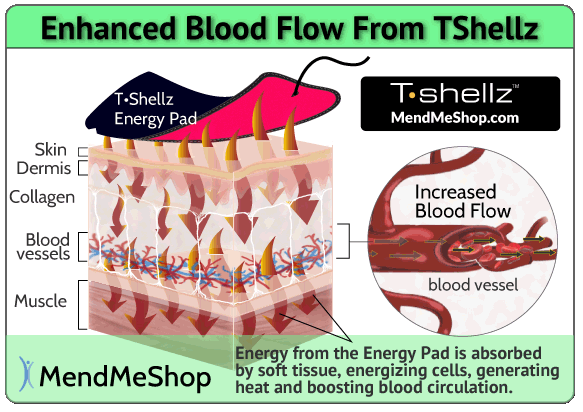
Shoulder Impingement Surgery
In most cases shoulder impingement syndrome can be treated without resorting to surgery. However, if conservative treatment methods have failed after for 6 full months of treatment, then your physician may opt for arthroscopic or open surgery on your shoulder. Arthroscopic surgery is becoming more and more popular, as it is considered less invasive and post surgery rehabilitation is usually quite a bit faster than rehabilitation for open surgery.
There are some cases that will require open surgery as the scope of arthroscopic surgery is limited in comparison to full exposure of the shoulder in open surgery. If you undergo an open surgery for your shoulder impingement, you should anticipate a longer period of time for rehabilitation efforts. Generally speaking, a patient will have more scar tissue from open surgery than a patient that has had arthroscopic surgery; this is part of the reason why arthroscopic shoulder impingement post-surgery rehab is shorter.
Surgery for shoulder impingement is sometimes required to make more physical space for the supraspinatus tendon to slide. This can be done a number of ways; removing part of the acromion, making the space between the acromion and humerus physically larger, or removing the subacromial bursa. Your doctor or surgeon will discuss your options with you and talk to you about the procedures and what to expect from the surgery. In most cases, a physician will run you through a course of conservative treatments before undergoing surgery, as outlined in our do I need surgery page.
However, if indeed you are scheduled for shoulder surgery or have recently had impingement surgery, please go to our surgery rehab page to learn the steps to a quick recovery.Recovery time for the surgery will depend a number of different factors including your healing ability, diet, rest, and the type of procedure done during surgery.
Shoulder Impingement Rehabilitation and Scar Tissue
As with any surgery, the surgeon will weigh the costs versus the benefits of performing surgery on a particular case. Scar tissue is something that cannot be avoided during surgery.
During the healing process your body will fill in tears in your tendons, muscles or ligaments with dense, brittle tissue called "scar tissue". The human body will use scar tissue as a temporary solution and will try to build the scar tissue as fast as possible to heal a strain or tear in your shoulder tissue.
Scar tissue is one of the MAIN reasons why your shoulder injury just hasn't healed. Even when the inflammation is gone, scar tissue will still be there to wreak havoc on your shoulder movement and range of motion. On-going issues with scar tissue can even result in a rotator cuff tear, a full rotator cuff tendon rupture, frozen shoulder, or some other shoulder injury.
Scar tissue will form fast to deal with a strain or tear to one of your tendons, or one of the ligaments in your shoulder, but working fast doesn't mean that the job's done right. When scar tissue forms it doesn't come together as neatly as regular (healthy) tissue would. Scar tissue fibers will lay down over top of your tear in a cluttered, messy and jumbled up way.
This is how scar tissue works. The scar tissue that forms to fix your tear will be unorganized and won't line up properly with the healthy tissue surrounding the injury site. This scar tissue will also attach to everything in that area, including the surrounding healthy tissue as well. This can result in a long-term fusing together of the soft tissue in your shoulder that stiffens your joint reducing your mobility and making your injury even more painful!
This is why scar tissue is weak and only a temporary solution to heal your shoulder. Scar tissue is something that needs to be dealt with fast. If you try to get back into your regular daily activities with a mound of scar tissue in your shoulder you will have a higher risk of reinjury. Scar tissue is just not built to withstand the pressures of regular activity.
Surgery may end up adding scar tissue to an already narrow space inside the shoulder. Even worse you could end up with frozen shoulder or another impingement. This is why surgery is only performed as a last resort.
Scar Tissue is a Serious and Problematic Issue for a LOT of People. This it is always important to heed the following points:
- Listen well to your physician and if conservative treatments are recommended, do all the treatments often to ensure you maximize the opportunity to avoid surgery. Stick to prescribed treatments daily to ensure you maximize your home recovery opportunity
- Frequent use of a Cold Compress or Ice Pack after your surgery will get the swelling down. In most cases, much of the pain you feel will be from the swelling, and you will be surprised how quick the pain drops off once the swelling is down.
- Consistent use of the Shoulder TShellz Wrap will help reduce reinjury risk and promote blood flow to the area (and thereby accelerate the body's own healing process).
- When applied before stretching or activity, the Shoulder TShellz Wrap will help elongate connective tissue in the treated area - as well as make it more flexible. This soft tissue will remain elongated for some time after treatment which is why we recommend a TShellz Wrap treatment before undergoing activity/stretching. This means that it helps improve your range of motion while minimizing risk of further strain - this is exactly what you want when trying to recover from a soft tissue injury.
It may seem hard to believe, but regardless of what type of shoulder surgery you have undergone (or are trying to prevent), our TShellz Wraps will assist you in your recovery, while reducing the risk of degenerative shoulder conditions by maximizing blood flow where it is needed most, and reducing swelling and inflammation induced pain.
With these simple and safe home treatment therapies you will notice significantly reduced pain and an incredible improvement in your rotator cuff range of motion.
Remember: Do not assume you have an impingement. Only your doctor can give a proper diagnosis and eliminate other causes of shoulder pain - some of these being very serious!
During your recovery, you may have to modify and/or eliminate any activities that cause pain or discomfort in your shoulder until your pain and inflammation settle and you gain more mobility and strength in your shoulder. The more diligent you are with your treatment and rehabilitation, the faster you will see successful results!
Click HERE to Go To Our Online Store We take all major credit cards and Paypal.
If you have questions, call our office at 1-866-237-9608 (toll free continental US).
We are currently offering FREE SHIPPING and a 60 day trial period on all our Wraps.
Product specialists are available 9:00 am to 5:00 pm Eastern Standard Time Monday to Friday. If any question or concern arises, call us or simply send us an email at any time (we check our emails constantly all throughout the day and night.. even on holidays!). We will respond as soon as possible. North America Toll Free 1-866-237-9608
Outside North America +1-705-532-1671
Learn More About The Rotator CuffLearn more about Shoulder Surgery and Post-Surgery Recovery Learn more about The TShellz Wrap Learn more about which is better for your rotator injury - ice or heat
FREE SHIPPING ON ALL PRODUCTS CURRENTLY ENABLED
60 DAY TRIAL PERIOD
During your recovery, you will probably have to modify and/or eliminate any activities that cause pain or discomfort at the location of your soft tissue injury until the pain and inflammation settle. The more diligent you are with your treatment and rehabilitation, the faster you will see successful results!
| 